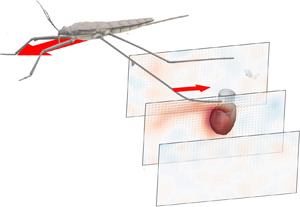Crossref Citations
This article has been cited by the following publications. This list is generated based on data provided by
Crossref.
Jami, Ludovic
Gustafson, Grey T.
Steinmann, Thomas
Piñeirua, Miguel
and
Casas, Jérôme
2021.
Overcoming Drag at the Water-Air Interface Constrains Body Size in Whirligig Beetles.
Fluids,
Vol. 6,
Issue. 7,
p.
249.
Starostin, Anton
Strelnikov, Vladimir
Dombrovsky, Leonid A.
Shoval, Shraga
and
Bormashenko, Edward
2022.
Three scenarios of freezing of liquid marbles.
Colloids and Surfaces A: Physicochemical and Engineering Aspects,
Vol. 636,
Issue. ,
p.
128125.
Kim, Woojoo
Pham, Thai Hong
Nguyen, Phuong Dung
Tran, Anh Duc
Ha, Jungmoon
Jablonski, Piotr G.
and
Lee, Sang-im
2022.
Locomotion and flow speed preferences in natural habitats by large water striders, Ptilomera tigrina, with micro-morphological adaptations for rowing.
Journal of Ethology,
Vol. 40,
Issue. 3,
p.
211.
Meshkani, J.
Rajabi, H.
Kovalev, A.
and
Gorb, S. N.
2023.
Patterns of load distribution among the legs in small water striders during standing and striding.
Journal of Zoology,
Vol. 320,
Issue. 2,
p.
84.
O’Neil, Johnathan N
Yung, Kai Lauren
Difini, Gaetano
Rohilla, Pankaj
and
Bhamla, Saad
2024.
Limb Loss and Specialized Leg Dynamics in Tiny Water-Walking Insects.
Integrative And Comparative Biology,
Vol. 64,
Issue. 3,
p.
1034.
O’Neil, Johnathan N
Yung, Kai Lauren
Difini, Gaetano
Walker, Holden
and
Bhamla, Saad
2024.
Tiny Amphibious Insects Use Tripod Gait for Traversal on Land, Water, and Duckweed.
Integrative And Comparative Biology,
Vol. 64,
Issue. 3,
p.
1044.
Kim, Woojoo
Lee, Jae Hong
Pham, Thai Hong
Tran, Anh Duc
Ha, Jungmoon
Bang, Sang Yun
Lee, Jeongseop
Jablonski, Piotr G.
Kim, Ho-Young
and
Lee, Sang-im
2024.
Physics of sliding on water explains morphological and behavioural allometry across a wide range of body sizes in water striders (Gerridae).
Proceedings of the Royal Society B: Biological Sciences,
Vol. 291,
Issue. 2037,
Aish, Annabelle
Broeckhoven, Chris
Buffa, Valentin
Challands, Tom
Du Plessis, Anton
Fletcher, Tom
Frey, Eberhard
Garrouste, Romain
Houssaye, Alexandra
Lecointre, Guillaume
Perricone, Valentina
Petit, Luce-Marie
Shyam, Vikram
Speck, Thomas
and
Habib, Michael
2025.
Palaeo-bioinspiration draws on the fossil record to advance innovation.
Communications Biology,
Vol. 8,
Issue. 1,
Lee, Jeongseop
Bang, Sang Yun
Kim, Woojoo
Jablonski, Piotr Grzegorz
and
Lee, Sang-im
2025.
Comparison of thrust-generation strategies, midleg microstructures, and their functions in small water striders: Metrocoris histrio (Halobatinae) and Gerris latiabdominis (Gerrinae).
Zoological Journal of the Linnean Society,
Vol. 205,
Issue. 1,
Ortega-Jimenez, Victor M.
Kim, Dongjin
Kumar, Sunny
Kim, Changhwan
Koh, Je-Sung
and
Bhamla, Saad
2025.
Ultrafast elastocapillary fans control agile maneuvering in ripple bugs and robots.
Science,
Vol. 389,
Issue. 6762,
p.
811.



